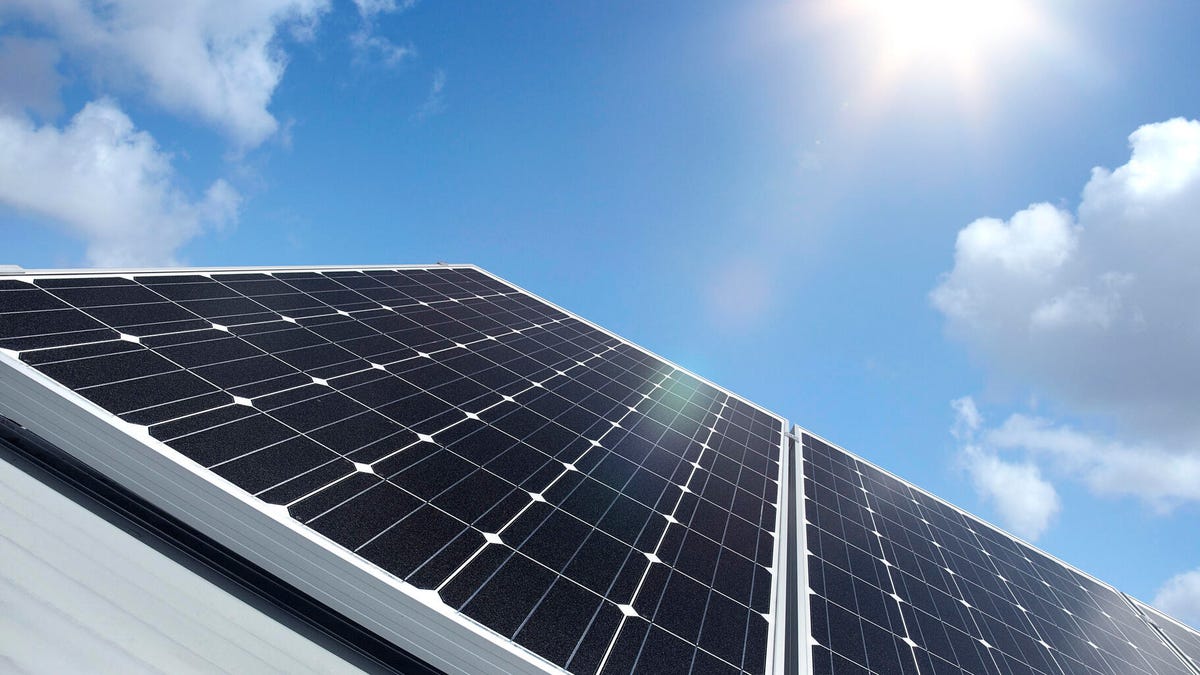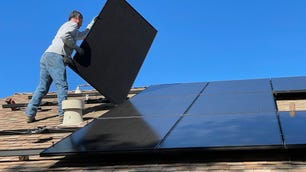
Sunlight has to hit solar panels for those panels to turn energy into electricity. As simple as it sounds, that means the angle of your solar panels matters a lot.
The problem is that the sun doesn’t stay in the same part of the sky all day. As the sun moves from the east to the west, the direction your solar panels face will determine when they collect the most power.
In most residential solar projects, the angle of panels will be determined by the pitch of a home’s roof.
Can solar panels save you money?
Interested in understanding the impact solar can have on your home? Enter some basic information below, and we’ll instantly provide a free estimate of your energy savings.
“If your home has a pitched roof, you typically want the panels to be flush to the roof,” said Tom McCalmont, CEO of Paired Power. “It’s usually not to any benefit to tilt.”
If you have the ability to customize the angle and direction of your solar panels, you could squeeze a bit more electricity out of them. Reputable solar companies should analyze and advise you on the best angle and direction for solar panels at your home.
Why does solar panel placement matter?
Photovoltaic solar panels work by absorbing sunlight to create electrical charges, which can be turned into electricity. This all starts with the panels collecting solar radiation. This comes primarily from the sun directly, but can also come from sunlight reflected from surrounding areas.
Because the primary source of solar radiation will be direct sunlight, your solar panels’ orientation will affect how much energy they’ll make and when.
Your home’s roof will typically face two directions. Ideally for solar power, one of those directions should be south (in the northern hemisphere) to face the equator, which receives more sun than the rest of the planet. Having a roof that doesn’t face south won’t disqualify your home from enjoying the benefits of solar, but you may need additional panels to compensate for any inefficiencies.
For solar projects that offer leeway for panel placement, there are a few factors to consider.
“It depends what you’re trying to optimize,” McCalmont said. “You can pick an angle that will optimize the energy value that you collect over a year, or you can pick an angle that optimizes the economic value. In the winter, the sun is down here, and in the summer, the sun is up here. If you’re trying to optimize the energy yield over the course of the year, you want to pick an angle that’s kind of the midpoint of those two extremes.”
Watch this: New Solar Shingles You May Not Even Notice
Solar panel orientation vs. angle
Think of your panel’s orientation as the direction it’s facing in terms of north, south, east and west. The angle is how flat (lying on its back and facing straight up) or tilted your panel is.
In the northern hemisphere, solar panels are generally going to be oriented so they’re facing south, which is the half of the sky where you’ll find the sun. If you’re in the southern hemisphere, you’ll want to point them towards the north.
Rooftop solar panels are typically installed flush to the roof, though there are a few exceptions, like these panels installed on a flat roof.
While orientation has to do with the cardinal direction of the sun, the ideal angle changes more slowly with the season and also depends on where you are on the globe. During winter the sun is lower to the horizon, making the ideal angle for panels closer to vertical. The opposite is true in summer.
The best direction for solar panels
The Earth’s equator, the line that splits the planet between the northern and southern hemispheres, gets the most direct sunlight year-round. Therefore, “In the northern hemisphere, it’s optimal for your solar panels to be facing south,” said Gilbert Michaud, assistant professor at Loyola University Chicago’s School of Environmental Sustainability. “This offers the best sun exposure throughout the course of a day, meaning that you’ll generate more electricity compared to facing any other direction.”
The reverse is true if you live in the southern hemisphere; you should orient your solar panels facing north so they will be exposed to sunlight all throughout the year.
Of course, not all global northerners’ roofs face south, which is OK. Solar panels can still collect the sun’s photons when facing other directions, just not as much as when facing south.
“There has also been a movement to face panels west, as their output will better match peak electricity demand in the evenings” Michaud said.
West-facing panels have been found to reduce a home’s reliance on the grid during peak hours more than south-facing alternatives. Nearly 25% of all solar installations in 2021 were oriented west, according to the Lawrence Berkeley National Laboratory (PDF), likely in order to generate more energy later in the day.
The best angle for solar panels
Angle also affects solar panel production. Optimally, sunlight would hit your panels perpendicularly, which results in the highest level of solar production. The angle of the panels can sometimes be modified during installation, although installing panels flush to the roof is most common.
There are two critical factors when it comes to the best angle for solar panels: what season it is and where you live. Joshua M. Pearce, a materials engineer who researches solar power systems at Western University in London, Ontario, recommends using this tool from Solmetric which recommends the ideal angle based on where you are. Typically, that’s between 30 to 45 degrees, although it should be lower in the summer and steeper in the winter.
“It is a quick simulation that will show the best tilt angle and direction to face your solar system, assuming it does not move,” he said. “As a general rule, if you live in a snowy environment you will want to err on the high tilt angle to reduce snow losses and take advantage of high snow albedo (the fraction of light that a surface reflects).”
A steeper angle in snowy climates might help solar panels clear themselves of snow and save you the work of clearing them yourself.
Determining the best solar panel angle by ZIP code
Some in the solar industry recommend using latitude as a means to determine the best angle, but McCalmont said that most people can ignore it: “Optimize for land costs or roof costs: how much space do you have available? How much energy are you trying to pack into that space? What are the differential costs from summer and winter utility rates?”
If you’re in a position to fine-tune your solar panel angle, online calculators like this one can help you determine the best angle for your specific location. That said, you probably don’t need to be so exact.
“In the United States, it’s simple. Forty-five degrees usually works,” said John Burke, director of the Maine Solar Energy Association. “If you’re further south or north you might want to adjust the angle a little bit. The rule of thumb is latitude, plus or minus 5 degrees.”
The effect of seasons on solar panel angle
In the US, the sun will be higher in the sky in the summer months and lower towards the horizon in the winter. You may want to adjust the angle of your panels, if possible, to lie flatter in the summer and closer to vertical in the summer to generate the maximum amount of electrons. Most residential solar panel customers will keep their panels at one angle throughout the year.
| Season | Ideal solar panel angle |
|---|---|
| Summer | 10 (Miami) to 20 (Seattle) degrees |
| Autumn | 24 to 35 degrees |
| Winter | 39 to 50 degrees |
| Spring | 24 to 35 degrees |
Factors affecting the optimum solar panel angle
The angle you choose to set your solar panels at may depend on how feasible it is for you to adjust them. Most people don’t have easy access to do this and will simply set them somewhere between 20 and 45 degrees.
There may be other considerations depending on your situation. For example, if it’s important for you to maximize limited sunlight during winter months and it’s not going to be easy for you to adjust your angle seasonally, then consider setting your panels at a more vertical angle.
Can I change my solar panels’ angle and direction?
As mentioned above, residential solar panels are usually installed to be flush with the roof. For other types of projects, including commercial rooftop solar or a ground-based solar farm, panels can be fitted with trackers, which allow the panels to “follow” the sun to boost efficiency over the course of the day.
“The reason that makes sense on a large commercial field is they can power that tracker with one motor that might control hundreds of panels, so the energy lost by powering that motor and the cost of that motor end up being pretty small in comparison to the energy from doing tracking,” McCalmont said. So essentially, it wouldn’t make sense for a small-scale residential project, not to mention that most residential panels aren’t installed to tilt.
There may be an instance where a homeowner may have a ground-based system — such as a prepper or someone who lives off the grid. In those cases, they may want to consider adjustable racks that allow the panel angle to be tweaked. Pearce is the co-creator of an open-source wood-based rack, the design of which is available here.
Solar panels that track the sun’s position throughout the day make the most economic sense for utility-scale solar farms.
Is angle or direction more important?
“Angle tends to be pretty straightforward to optimize for that economic value,” McCalmont said. “But direction is a little more challenging to do because it depends on the shape of your land, the shape of your building and the shape of your house.”
Any reputable solar company will do simulations of how much sunlight your property receives in a year and will also conduct a site survey to ensure your roof is not shaded by trees and receives enough sunlight for your energy needs.
“There are companies that will sell you anything, even if your roof is completely shaded,” McCalmont said. “You want a company who’s ethical and understands these factors.”
Frequently asked questions about solar panel angle
Is it worth tilting your solar panels?
Absolutely. Pick an angle that maximizes solar energy potential for your location. Most people will likely install panels at the angle of their roof, but you might have the option in some cases, like if you’re installing ground-mounted panels.
What is the best direction for solar panels?
If the goal is to maximize energy generation throughout the year and space is not an issue, panels should be oriented to the south if in the northern hemisphere and to the north if in the southern hemisphere.
Do solar panels need to be south-facing?
In the northern hemisphere, you’ll generate more energy per day with south-facing solar panels. Sometimes solar panels are installed facing another direction to generate more energy at other parts of the day, or because there’s not enough roof space.
Why does solar panel angle matter?
Angle can maximize solar energy production by ensuring that the sun’s rays strike a panel’s cells directly.

